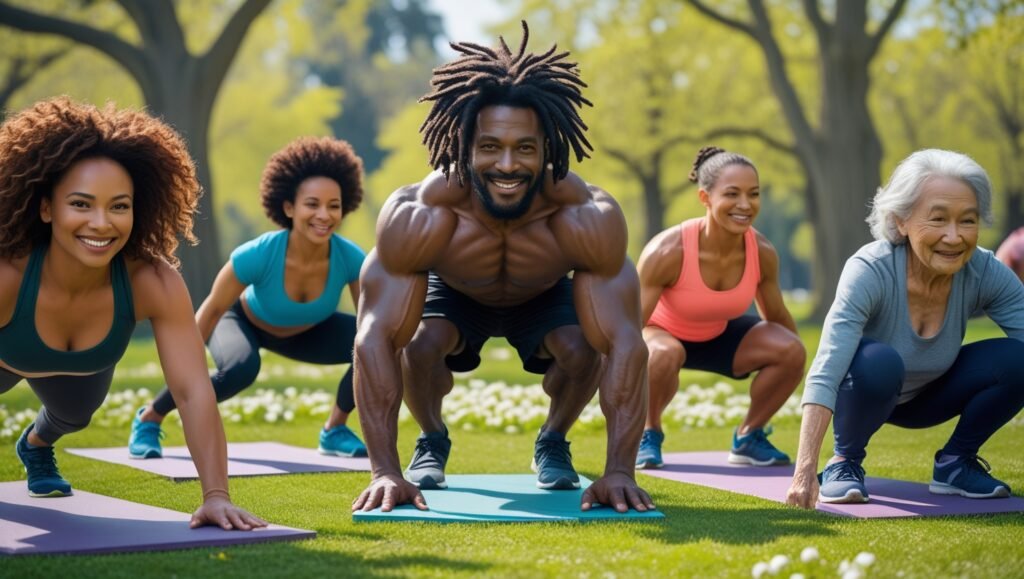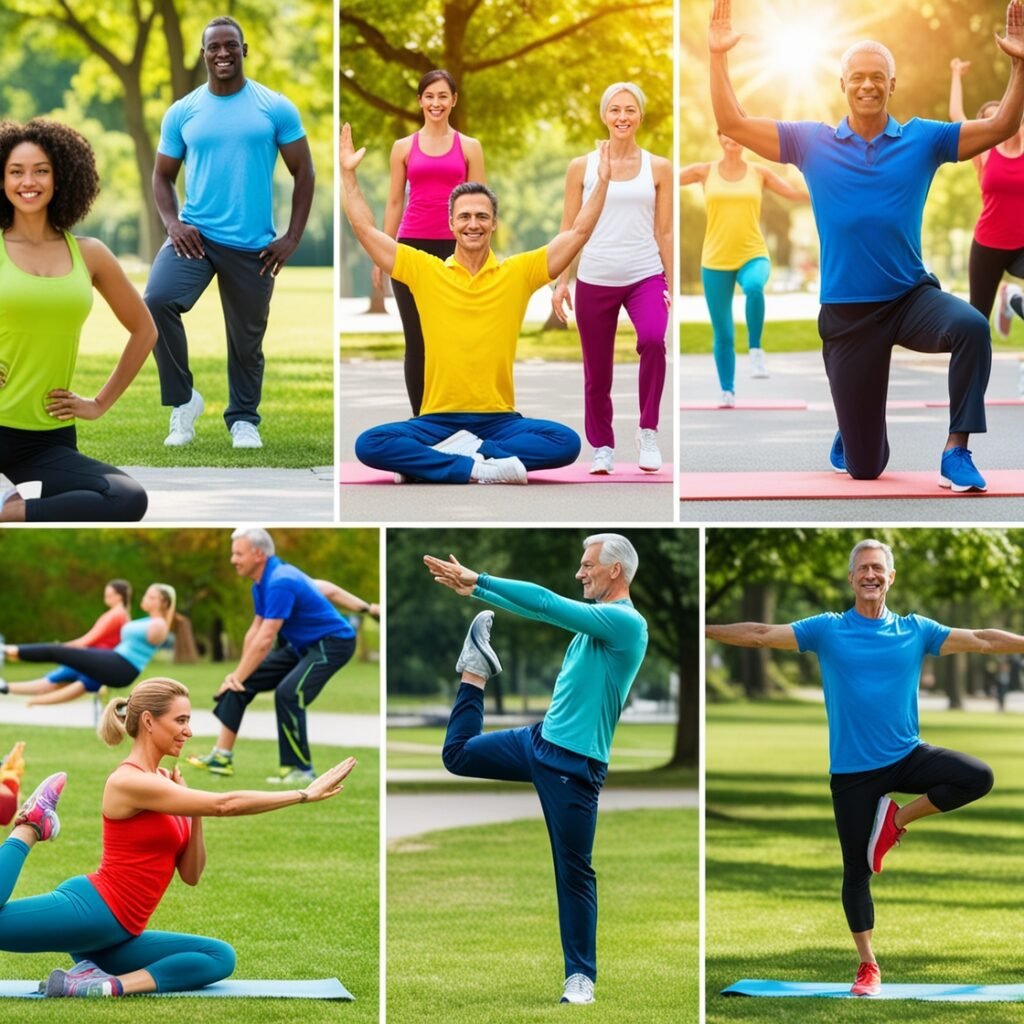Introduction to Exercising Without Equipment
Have you ever found yourself skipping workouts due to a busy schedule or a lack of access to gym equipment? You’re not alone. Many of us face the challenge of maintaining our fitness routines when life gets hectic or when we’re away from home. The good news is that you can achieve remarkable fitness results through exercising without equipment. This approach not only eliminates the need for expensive gym memberships or bulky gear but also offers flexibility and convenience, allowing you to work out anywhere—be it at home, in the office, or even while traveling.
Imagine being able to sculpt your body and boost your cardiovascular health using just your body weight. Sounds appealing, right? Bodyweight exercises, such as push-ups, squats, and lunges, are incredibly effective for building strength and endurance. They engage multiple muscle groups simultaneously, providing a comprehensive workout that challenges both your body and mind. Plus, these exercises can be easily modified to suit any fitness level, making them accessible for beginners and seasoned athletes alike.
In this blog post, we’ll explore the numerous benefits of bodyweight training, delve into various exercises you can do without equipment, and guide you to create an effective workout routine of exercising without equipment to achieve your goals. We’ll also share tips on staying motivated and overcoming common challenges that might hinder your progress. So, whether you’re looking to maintain your fitness while on vacation or want a quick workout at home, this guide will equip you with everything you need to succeed in your journey toward better health. Let’s get started on discovering the power of exercising without equipment!
Table of Contents
Exercising Without Equipment
Benefits of Exercising Without Equipment
When you think about getting fit, what comes to mind? A gym filled with machines, weights, and memberships? While traditional workouts have their place, exercising without equipment opens up a world of possibilities that can be just as effective—if not more so! Let’s explore the incredible benefits of bodyweight training and why it might be the perfect solution for you.
1. Accessibility and Convenience
One of the most significant advantages of exercising without equipment is its accessibility. You don’t need a fancy gym or expensive gear to get started. Whether you’re at home, in a hotel room, or even at the park, your body is all you need. This convenience means you can fit in a workout whenever it suits you—no excuses!
2. Cost-Effective Fitness
Let’s face it: gym memberships can be pricey. By opting for bodyweight exercises, you can save money while still achieving your fitness goals. Imagine investing that cash into something else—like a new hobby or a weekend getaway! With exercises like push-ups, squats, and planks, you can build strength and endurance without spending a dime.
3. Versatility and Variety
Are you tired of the same old routine? Bodyweight workouts offer incredible versatility. You can mix and match exercises to keep your workouts fresh and exciting. Here are some ideas to keep things interesting:
- Strength Training: Incorporate push-ups, squats, lunges, and tricep dips.
- Cardio Workouts: Try jumping jacks, burpees, or high knees to get your heart pumping.
- Flexibility: Don’t forget about stretching! Incorporate yoga poses or dynamic stretches to enhance flexibility.
4. Full Body Engagement
Did you know that bodyweight exercises often engage multiple muscle groups at once? This means you can achieve a comprehensive workout that targets your entire body effectively. For example:
- Push-ups work your chest, shoulders, triceps, and core.
- Squats target your legs while also engaging your core for stability.
- Planks challenge your entire body, focusing on core strength while also working your arms and legs.
By engaging multiple muscles simultaneously, you’re not only saving time but also maximizing the effectiveness of each workout.
5. Improved Functional Fitness
Exercising without equipment helps improve functional fitness—the type of strength and endurance that translates into everyday activities. Think about it: when you squat down to pick something up or push yourself off the ground after a fall, those movements rely on the same muscles you train with bodyweight exercises. This functional approach enhances your overall quality of life by making daily tasks easier and safer.
6. Enhanced Mental Well-being
Let’s not overlook the mental health benefits! Regular physical activity is known to reduce stress and anxiety while boosting mood and energy levels. When you engage in exercising without equipment, you’re not just working on your physical health; you’re also nurturing your mental well-being. The endorphins released during exercise can leave you feeling accomplished and invigorated.
As we’ve seen, there are numerous compelling reasons to embrace exercising without equipment. From its accessibility and cost-effectiveness to its ability to engage multiple muscle groups and enhance mental well-being, this approach offers something for everyone. So why not give it a try? Your body—and mind—will thank you!
Types of Bodyweight Exercises
Are you ready to dive into the world of bodyweight exercises? If you’re searching for exercising without equipment, you’re in the right place! Bodyweight training is not only effective but also incredibly versatile. Let’s explore the types of bodyweight exercises that can help you build strength, improve endurance, and enhance flexibility—all from the comfort of your own home or anywhere you choose to work out.

1. Strength Training Exercises
Strength training is a crucial component of any fitness routine, and bodyweight exercises can deliver fantastic results. Here are some key movements to include:
- Push-Ups: A classic exercise that targets your chest, shoulders, triceps, and core. You can modify them by doing knee push-ups or incline push-ups if you’re just starting out.
- Squats: Excellent for building strength in your legs and glutes. To increase the challenge, try jump squats or single-leg squats.
- Lunges: Great for targeting your quads, hamstrings, and glutes. You can mix it up with forward lunges, reverse lunges, or lateral lunges.
- Planks: This exercise engages your entire core while also working your shoulders and legs. Try variations like side planks or plank jacks to keep things interesting.
2. Cardiovascular Workouts
Cardio is essential for heart health and burning calories. Here are some dynamic bodyweight exercises that will get your heart racing:
- Burpees: A full-body exercise that combines a squat, push-up, and jump. Burpees are fantastic for building strength and endurance in one go.
- Jumping Jacks: A simple yet effective way to elevate your heart rate. They can be done anywhere and are perfect for warming up or adding intensity to your workout.
- High Knees: This exercise not only boosts your heart rate but also engages your core and legs. Try incorporating high knees into a circuit for an extra challenge.
3. Flexibility and Mobility Exercises
Don’t forget about flexibility! Incorporating stretching and mobility work into your routine is vital for overall fitness. Here are some key exercises:
- Yoga Poses: Incorporate poses like Downward Dog, Warrior II, and Child’s Pose to improve flexibility and promote relaxation.
- Dynamic Stretches: Movements such as leg swings or arm circles can help warm up your muscles before a workout.
- Static Stretches: After your workout, take time to stretch major muscle groups to enhance flexibility and aid recovery.
4. Core Strengthening Exercises
A strong core is essential for overall stability and performance in other exercises. Here are some effective bodyweight moves to strengthen your core:
- Mountain Climbers: This exercise works your core while also providing a cardio boost. It’s perfect for getting your heart rate up while building strength.
- Russian Twists: Great for targeting the obliques, this exercise can be done seated on the floor or elevated on a bench.
- Leg Raises: A fantastic way to target the lower abdominal muscles. Make sure to keep your lower back pressed into the floor as you lift your legs.
5. Combining Exercises into a Routine
The beauty of bodyweight training lies in its versatility. You can easily combine different types of exercises into a well-rounded routine that suits your fitness level and goals. Here’s a simple example of how you might structure a workout:
- Warm-Up (5 minutes): Start with jumping jacks and dynamic stretches.
- Strength Circuit (15 minutes): Perform three rounds of push-ups, squats, lunges, and planks.
- Cardio Burst (5 minutes): Do burpees followed by high knees.
- Core Workout (10 minutes): Finish with mountain climbers, Russian twists, and leg raises.
- Cool Down (5 minutes): Conclude with static stretches focusing on major muscle groups.
With many options available, you can easily customize your workouts to keep things fresh and exciting! Whether you’re focusing on strength training, cardio, flexibility, or core work, bodyweight exercises offer an effective way to achieve your fitness goals by exercising without equipment. So why wait? Start exploring these movements today and discover how empowering it feels to work out using just your body!
Creating a Workout Routine for Exercising Without Equipment
Are you ready to take control of your fitness journey? Crafting a personalized workout routine can be one of the most empowering steps you can take. Whether you’re a beginner or a seasoned athlete, having a structured plan helps you stay focused, motivated, and on track to achieve your goals. Let’s break down how to create an effective workout routine that incorporates exercising without equipment and fits seamlessly into your lifestyle.

1. Assess Your Fitness Level
Before diving into a new routine, it’s essential to understand where you stand. Ask yourself:
- What is my current fitness level?
- Have I exercised regularly in the past?
- Are there any physical limitations or injuries I need to consider?
By answering these questions, you can tailor your routine to meet your specific needs. If you’re just starting out, don’t worry! Bodyweight exercises are highly adaptable and can be modified to suit any level of fitness.
2. Set Clear Goals
What do you want to achieve with your workouts? Setting clear and realistic goals is crucial for maintaining motivation. Consider the following types of goals:
- Short-term goals: These could include completing a certain number of workouts per week or mastering a specific exercise.
- Long-term goals: Think about what you want to accomplish in the next few months, such as improving endurance or building strength.
Write down your goals and keep them visible as a constant reminder of what you’re working towards.
3. Structure Your Routine
Now that you have a clear understanding of your fitness level and goals, it’s time to structure your workout routine. Here’s a simple framework to get you started:
A. Warm-Up (5-10 minutes)
Always begin with a warm-up to prepare your body for exercise and reduce the risk of injury. You might include:
- Dynamic stretches (arm circles, leg swings)
- Light cardio (jumping jacks, high knees)
B. Main Workout (20-30 minutes)
This is where the magic happens! Depending on your goals, you can focus on strength training, cardio, or a combination of both. Here’s an example of how to structure this section:
- Strength Training: Alternate between upper body (push-ups, triceps dips) and lower body exercises (squats, lunges).
- Cardio Intervals: Incorporate high-intensity intervals like burpees or mountain climbers for an added challenge.
C. Cool Down (5-10 minutes)
Finish with a cool-down to help your body recover and improve flexibility. Include:
- Static stretches targeting major muscle groups
- Deep breathing exercises to relax
4. Balance Your Routine
To achieve well-rounded fitness, ensure that your routine includes a mix of strength training, cardio, and flexibility work. Here’s how to balance these components:
- Frequency: Aim for at least three days of strength training and two days of cardio each week.
- Variety: Keep things interesting by rotating exercises and trying new movements regularly.
5. Track Your Progress
Monitoring your progress is vital for staying motivated and making adjustments as needed. Here are some effective ways to track your workouts:
- Fitness Apps: Use apps that allow you to log workouts and set reminders.
- Journaling: Keep a fitness journal where you note down exercises completed, duration, and how you felt during each session.
6. Stay Flexible
Life can be unpredictable! It’s important to remain flexible with your routine. If something comes up that prevents you from sticking to your plan, don’t stress—just adjust as needed. Consistency is key, but so is being adaptable.
Creating a workout routine tailored specifically for exercising without equipment empowers you to take charge of your fitness journey. By assessing your fitness level, setting clear goals, structuring your workouts effectively, balancing different exercise types, tracking progress, and staying flexible, you’ll be well on your way to achieving lasting results. So grab a mat or find some space on the floor—your journey begins now!
Exercising Without Equipment: Tips for Staying Motivated
Staying motivated on your fitness journey can sometimes feel like an uphill battle. We all have days when we’d rather binge-watch our favorite show than hit the floor for a workout. But don’t worry! With the right strategies, you can keep your motivation high and make exercising without equipment a rewarding part of your daily routine. Let’s explore some effective tips to help you stay engaged and excited about exercising without equipment.

1. Set Specific Goals
Have you ever tried to reach a destination without a map? It’s tough! The same goes for your fitness journey. Setting specific, measurable goals can provide you with direction and purpose. Consider these types of goals:
- Performance Goals: Aim to complete a certain number of push-ups or squats in one session.
- Consistency Goals: Commit to working out a specific number of days each week.
By breaking your larger objectives into smaller, achievable milestones, you’ll be able to celebrate progress along the way!
2. Create a Schedule
Just like any important appointment, scheduling your workouts can help ensure you stick to them. Here’s how to create an effective workout schedule:
- Choose Your Days: Decide which days of the week you’ll dedicate to exercise.
- Set Time Blocks: Allocate specific times for your workouts, treating them as non-negotiable commitments.
- Be Realistic: Make sure your schedule aligns with your lifestyle to avoid burnout.
Having a clear plan makes it easier to prioritize fitness amidst life’s demands.
3. Find a Workout Buddy
Do you remember how much more fun it was to play games with friends? The same principle applies to working out! Exercising with a friend or family member can significantly boost your motivation. Here’s why:
- Accountability: Knowing someone is counting on you can encourage you to show up.
- Support: A workout buddy can offer encouragement and celebrate your achievements with you.
- Variety: You can mix up your routines by trying new exercises together.
So reach out to someone who shares your fitness goals and make plans to work out together!
4. Keep It Fun and Varied
Boredom is one of the biggest motivation killers. To keep things exciting, try incorporating variety into your workouts:
- Mix Up Exercises: Rotate between strength training, cardio, and flexibility exercises.
- Explore New Formats: Try online classes, follow workout videos, or join virtual challenges.
- Set Challenges: Challenge yourself with new goals, like mastering a difficult exercise or increasing the duration of your workouts.
The more fun and varied your routine is, the more likely you are to stick with it!
5. Track Your Progress
Seeing how far you’ve come can be incredibly motivating. Here are some ways to track your progress effectively:
- Fitness Apps: Use apps that allow you to log workouts, track performance, and monitor improvements over time.
- Journaling: Keep a workout journal where you note down exercises completed, duration, and how you felt during each session.
- Celebrate Milestones: Reward yourself when you reach specific goals—whether it’s treating yourself to new workout gear or enjoying a relaxing day off.
Tracking progress not only keeps you accountable but also reinforces the positive changes you’re making.
6. Embrace Mindfulness and Positive Thinking
Your mindset plays a crucial role in staying motivated. Incorporating mindfulness techniques can help keep negativity at bay:
- Practice Gratitude: Reflect on what you’re grateful for in your fitness journey—like improved energy levels or enhanced mood.
- Visualize Success: Picture yourself achieving your goals; this mental imagery can boost confidence and motivation.
- Positive Affirmations: Use affirmations to reinforce your commitment—statements like “I am strong” or “I enjoy exercising” can shift your mindset.
A positive attitude can make all the difference in maintaining motivation over time.
Staying motivated on your fitness journey doesn’t have to be daunting! By setting specific goals, creating a consistent schedule, finding a workout buddy, keeping things fun and varied, tracking your progress, and embracing mindfulness, you’ll cultivate an environment that fosters motivation and success. Remember, every step counts—so keep moving forward and enjoy the process of exercising without equipment! You’ve got this!
Exercising Without Equipment: Overcoming Common Challenges
Embarking on a fitness journey can be incredibly rewarding, but it’s not without its hurdles. Whether you’re struggling to find time, battling boredom, or dealing with self-doubt, overcoming these common challenges is essential for maintaining your commitment to exercising without equipment. Let’s explore some of the most frequent obstacles and how you can tackle them head-on.
1. Time Management
Do you often feel like there just aren’t enough hours in the day to squeeze in a workout? You’re not alone! Time management is a common barrier to regular exercise. Here are some strategies to help you make time for fitness:
- Prioritize Your Workouts: Treat your workouts like important appointments. Schedule them into your calendar and stick to them.
- Opt for Shorter Sessions: Even a quick 15-20 minute workout can be effective. High-intensity interval training (HIIT) is a great option that maximizes results in minimal time.
- Incorporate Movement into Your Day: Look for opportunities to stay active throughout your daily routine—take the stairs, go for a walk during lunch, or do a few exercises while watching TV.
By being intentional about your time, you can easily fit exercise into your busy life.
2. Boredom with Routine
Have you ever found yourself yawning during a workout? Boredom can quickly derail your motivation. To keep things fresh and exciting, consider these tips:
- Mix Up Your Exercises: Rotate different bodyweight exercises into your routine to target various muscle groups and keep things interesting.
- Try New Formats: Explore online classes, follow workout videos, or join virtual fitness challenges. New formats can reignite your enthusiasm for exercise.
- Set Challenges: Challenge yourself to learn a new skill or achieve a personal best—like increasing the number of push-ups you can do in one set.
Keeping your workouts varied will help maintain your interest and excitement.
3. Lack of Equipment
While exercising without equipment is incredibly convenient, some may feel limited by the absence of weights or machines. Here’s how to overcome that mindset:
- Get Creative: Use household items as makeshift weights—think water bottles, backpacks filled with books, or even chairs for tricep dips.
- Focus on Bodyweight Exercises: Remember that bodyweight exercises can be highly effective. Push-ups, squats, lunges, and planks engage multiple muscle groups and can be modified for increased intensity.
- Explore Online Resources: There are countless free resources available online that provide bodyweight workout routines designed to challenge you without any equipment.
With a little creativity, you can turn your environment into an effective workout space!
4. Self-Doubt and Lack of Confidence
Do you sometimes feel intimidated by the idea of working out at home or trying new exercises? It’s completely normal to experience self-doubt. Here’s how to build confidence in your abilities:
- Start Small: Begin with exercises that feel manageable and gradually increase the intensity as you gain strength and confidence.
- Celebrate Progress: Keep track of your achievements—no matter how small. Recognizing progress boosts self-esteem and reinforces positive habits.
- Join Online Communities: Engage with supportive online fitness communities where you can share experiences, ask questions, and celebrate each other’s successes.
Remember, everyone starts somewhere! Embrace your journey and focus on personal growth.
5. Staying Consistent
Consistency is key when it comes to fitness, but it can also be one of the toughest challenges to overcome. To help you stay on track:
- Create a Routine: Establishing a consistent workout schedule helps build habit. Try to work out at the same time each day or week.
- Use Reminders: Set alarms or calendar notifications to remind yourself when it’s time to work out.
- Find Accountability: Share your goals with friends or family members who can help keep you accountable. Alternatively, consider joining virtual fitness groups for additional support.
By making consistency a priority, you’ll find it easier to stick with your routine over time.
Overcoming challenges on your fitness journey is all about finding solutions that work for you. By managing your time effectively, keeping workouts fresh, getting creative with equipment alternatives, building confidence, and staying consistent, you’ll pave the way for success in exercising without equipment. Remember, every challenge is an opportunity for growth—embrace it and keep moving forward!
Conclusion of Exercising Without Equipment
As we wrap up our exploration of exercising without equipment, it’s clear that this approach to fitness offers a wealth of benefits that can fit seamlessly into your lifestyle. Have you considered how liberating it can be to rely solely on your body for strength and conditioning? Whether you’re at home, traveling, or simply looking for a more accessible way to stay fit, bodyweight exercises provide an effective solution that requires no gym membership or fancy equipment.
Throughout this journey, we’ve discussed the many advantages of bodyweight training—from its cost-effectiveness and versatility to its ability to engage multiple muscle groups. We’ve also explored practical tips for creating a workout routine, staying motivated, and overcoming common challenges. Each of these elements plays a crucial role in helping you achieve your fitness goals.
So, what’s next for you? Are you ready to take the plunge and incorporate more bodyweight exercises into your routine? Remember, the key to success lies in consistency and adaptability. As you embark on this journey, keep in mind that every small step counts. Celebrate your progress, no matter how minor it may seem, and don’t hesitate to mix things up to keep your workouts exciting.
As you continue to explore the world of exercising without equipment, allow yourself the freedom to experiment with different exercises and routines. Embrace the process, and remember that fitness is not just about the destination; it’s about enjoying the journey along the way.
Thank you for joining us on this exploration of exercising without equipment. We hope you feel inspired and equipped with the knowledge needed to make informed choices about your fitness. Now roll out that mat, find a space, and get moving! Your body will thank you for it!
Exercising Without Equipment: Citations
[1] https://sciendo.com/article/10.1515/pjst-2015-0014
[2] https://www.health.harvard.edu/exercise-and-fitness/the-advantages-of-body-weight-exercise
[3] https://www.menshealth.com/uk/building-muscle/train-smarter/a61468531/barbell-back-squat-vs-single-leg-squat/
[4] https://pmc.ncbi.nlm.nih.gov/articles/PMC8136567/
[5] https://www.nature.com/articles/s41598-023-40319-x
[6] https://pubmed.ncbi.nlm.nih.gov/37133323/
[7] https://physoc.onlinelibrary.wiley.com/doi/10.1113/EP090655




